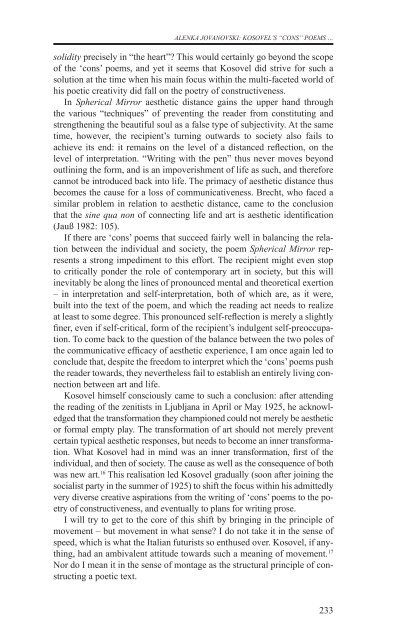razprave (pdf) - Društvo za primerjalno književnost - ZRC SAZU
razprave (pdf) - Društvo za primerjalno književnost - ZRC SAZU
razprave (pdf) - Društvo za primerjalno književnost - ZRC SAZU
- No tags were found...
Create successful ePaper yourself
Turn your PDF publications into a flip-book with our unique Google optimized e-Paper software.
alenka jovanovski: Kosovel’s “Cons” Poems …solidity precisely in “the heart”? This would certainly go beyond the scopeof the ‘cons’ poems, and yet it seems that Kosovel did strive for such asolution at the time when his main focus within the multi-faceted world ofhis poetic creativity did fall on the poetry of constructiveness.In Spherical Mirror aesthetic distance gains the upper hand throughthe various “techniques” of preventing the reader from constituting andstrengthening the beautiful soul as a false type of subjectivity. At the sametime, however, the recipient’s turning outwards to society also fails toachieve its end: it remains on the level of a distanced reflection, on thelevel of interpretation. “Writing with the pen” thus never moves beyondoutlining the form, and is an impoverishment of life as such, and thereforecannot be introduced back into life. The primacy of aesthetic distance thusbecomes the cause for a loss of communicativeness. Brecht, who faced asimilar problem in relation to aesthetic distance, came to the conclusionthat the sine qua non of connecting life and art is aesthetic identification(Jauß 1982: 105).If there are ‘cons’ poems that succeed fairly well in balancing the relationbetween the individual and society, the poem Spherical Mirror representsa strong impediment to this effort. The recipient might even stopto critically ponder the role of contemporary art in society, but this willinevitably be along the lines of pronounced mental and theoretical exertion– in interpretation and self-interpretation, both of which are, as it were,built into the text of the poem, and which the reading act needs to realizeat least to some degree. This pronounced self-reflection is merely a slightlyfiner, even if self-critical, form of the recipient’s indulgent self-preoccupation.To come back to the question of the balance between the two poles ofthe communicative efficacy of aesthetic experience, I am once again led toconclude that, despite the freedom to interpret which the ‘cons’ poems pushthe reader towards, they nevertheless fail to establish an entirely living connectionbetween art and life.Kosovel himself consciously came to such a conclusion: after attendingthe reading of the zenitists in Ljubljana in April or May 1925, he acknowledgedthat the transformation they championed could not merely be aestheticor formal empty play. The transformation of art should not merely preventcertain typical aesthetic responses, but needs to become an inner transformation.What Kosovel had in mind was an inner transformation, first of theindividual, and then of society. The cause as well as the consequence of bothwas new art. 16 This realisation led Kosovel gradually (soon after joining thesocialist party in the summer of 1925) to shift the focus within his admittedlyvery diverse creative aspirations from the writing of ‘cons’ poems to the poetryof constructiveness, and eventually to plans for writing prose.I will try to get to the core of this shift by bringing in the principle ofmovement – but movement in what sense? I do not take it in the sense ofspeed, which is what the Italian futurists so enthused over. Kosovel, if anything,had an ambivalent attitude towards such a meaning of movement. 17Nor do I mean it in the sense of montage as the structural principle of constructinga poetic text.233
















